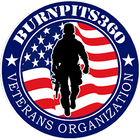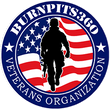Concerns for Action: Medical and Disability Management of Constrictive Bronchiolitis Post PACT Act

To Download and distribute this letter, click here.
Robert Miller, MD
Paul Barach, MD, MPH, Maj, (Ret)
Julie Tomaska, PhD, USAF, (Ret)
Tammy Butterick, PhD
Kerry Baker, USMC (Ret)
Rosie Torres, CEO Burn Pits 360
Introduction:
President Biden signed the Sergeant First Class Heath Robinson Honoring our PACT Act in August 2022. The legislation recognized bodily disorders related to toxic exposures during deployment. It added 23 presumptive diagnoses with the intent of reducing the burden of proof for Veterans with medical conditions related to burn pit and other toxic exposures. Respiratory symptoms and disorders which commonly follow deployment have been linked to burn pits, and consistently high ambient particulate matter (PM10 and PM2.5) associated with both Iraq and Afghanistan theaters.(1)
Service members with respiratory disorders including asthma, rhinitis and sinusitis represent a large number of those affected by burn pit exposure. They were recognized as being deployment related prior to passage of the PACT Act. Their treatment and related disability claims appear to be ongoing and Veteran-centric.
Other post-deployment respiratory disorders including unexplained shortness of breath and constrictive bronchiolitis were addressed by the PACT Act but attention to these disorders have been delayed or deferred. Such responses can lead to poor medical care, and denial of disability ratings and financial benefits for thousands of Veterans.
Unexplained shortness of breath and constrictive bronchiolitis in the setting of deployment pose challenges to the system. DOD sponsored research estimates that 30% of Veterans presenting with shortness of breath do not have an identifiable disorder to explain their symptoms after completing standard respiratory examinations which include x-rays, pulmonary function testing and exercise testing. (2) Centers that have also included surgical lung biopsy as part of their evaluations of deployers have identified toxic lung injury in this group. Biopsies have typically revealed extensive toxic lung injury including constrictive bronchiolitis. (3,4,5,6,7,8)
Deployers demonstrating toxic lung injury on biopsy usually have remarkably normal or near normal pulmonary function testing, exercise testing and lung imaging. Over 300 service members have undergone lung biopsy and have been diagnosed with constrictive bronchiolitis or other manifestations of toxic lung injury. However, thousands of service members are experiencing post-deployment shortness of breath but have not been biopsied.(9) Secretary McDonough has recognized this issue and has requested a process to evaluate and provide reliable disability ratings for this group without having them undergo invasive and costly lung biopsies. These ratings are critical as they determine disabled Veteran’s monthly income.
We have seen hundreds of service members with shortness of breath and are concerned that the PACT Act has yet to remove the burden of proof from Veterans experiencing unexplained shortness of breath and those who have biopsy-proven constrictive bronchiolitis. Here are our concerns:
- Symptomatic Veterans presenting with unexplained shortness of breath are being dismissed because VA providers do not know how to reliably evaluate them.
- Veterans with biopsy-proven toxic lung injury, including constrictive bronchiolitis are not receiving disability benefits.
- The Veterans Benefits Administration (VBA) has not created a four-digit diagnosis code for constrictive bronchiolitis or what some would like to label “Deployment Related Respiratory Disorder”.
- The VBA has failed to create a disability rating for Veterans who meet clinical criteria for constrictive bronchiolitis but without biopsy confirmation.
- Veterans with biopsy-confirmed toxic lung injury and those who are symptomatic but have not been biopsied are not receiving disability benefits.
- In the absence of a diagnosis code, VA decision makers select other respiratory codes by analogy, which routinely prevent disability ratings commensurate with the Veteran’s level of functional limitation.
- In light of no diagnostic codes that adequately compensate for such functional limitation, rating activities still do not request extra-schedular ratings from VA Central Office as instructed in policy.
- VA examiners and contract examiners, lack vital training on all elements above and below, to include the fundamental legal mandates that govern their own opinions/examinations.
Patient Examples:
TT, (Tennessee): He is a 55 y/o Army National Guard intelligence officer who was deployed to Balad, Iraq in 2010. He had extensive burn pit exposure during deployment and had difficulty passing a two-mile run test on return. Prior to deployment, he ran half-marathons without limitation. He has not undergone a lung biopsy but meets the criteria of servicemembers who have been diagnosed with constrictive bronchiolitis. The VA has denied his disability benefits for unexplained exercise limitation despite his having completed a full evaluation at a center with extensive experience with this disorder.
JT, (Minnesota): She is a 45 y/o who served in the Air Force for 22 years. She was in excellent health when deployed to Balad, Iraq in 2005 and 2007 where she had regular exposure to burn pits and sand storms (non-smoker, non-drinker). She presented with unexplained shortness of breath and underwent surgical biopsy in 2018. Her biopsy demonstrated Constrictive Bronchiolitis, Emphysema, Plural Fibrosis, and Chronic Pleuritis. Her lung biopsy pathology report also noted visible soot on lungs and metals found in lung tissue. She was also diagnosed with Postural Orthostatic Tachycardia Syndrome (POTS) autonomic nervous system disorder in 2018. She filed a claim with the VA in 2018, and was denied benefits with biopsy proven small airways disease. The veteran went through the appeal process in 2020 after obtaining legal counsel and was granted benefits in 2021.
ML, (Tennessee): He is a 68 y/o who served in the Army for 10 years. He was in excellent health when deployed to Balad, Iraq in 2004 where he had regular exposure to burn pits and brick factory smokestacks. He had difficulty completing a two-mile run following this deployment and as well at the time of his second deployment to Afghanistan in 2007. He was diagnosed with adenocarcinoma of the lung in 2020 having been a lifetime non-smoker. He is not receiving disability for his lung cancer or his unexplained shortness of breath. A provider contracted by the VA has declared his lung function as being normal based on an FEV1/FVC ratio. This is despite all other PFT parameters being well below normal and being consistent with his exercise limitation.
JR, (Alabama): He is a 59 y/o who worked in intelligence and counterterrorism. He was deployed to Afghanistan for 15 months in 2006-2007 with exposure to burn pits and dust storms. He had unexplained shortness of breath on return and ultimately underwent surgical lung biopsy in 2012. Lung biopsy revealed non-occlusive constrictive, and chronic inflammatory bronchiolitis and emphysema. More specifically, the biopsy showed non occlusive bronchiolar luminal narrowing by a mix of smooth muscle and scar tissue. Also present was emphysematous changes and significant hypertensive-type remodeling of vessels, foci of organizing pneumonia, chronic inflammation of small airways, mucus plugging of small airways, peribronchiolar metaplasia and prominent BALT (Bronchus-associated lymphoid tissue). He is a lifelong non-smoker. He has been consistently turned down for a compensable disability rating despite having significant functional limitation.
JW, (Alabama): He is a 65 y/o retired Air Force helicopter pilot who had a total of 4 deployments to Iraq and Afghanistan. He presented with unexplained shortness of breath and underwent surgical biopsy in 2010. His biopsy demonstrated extensive small airway inflammation and constrictive bronchiolitis. He has applied for VA disability several times and has been denied. He had exposure to burn pits, dust storms and the fire at the Mishraq Sulfur Mine Plant near Mosul in 2003. A VA training letter issued in 2009 stated that constrictive bronchiolitis should be linked to the sulfur mine fire.
MT (Tennessee): 58 y/o Colonel served in Iraq from December 2004 through November 2005 as a Combat Engineer. (non-smoker, non-drinker). Veteran developed a “chronic cough” while deployed to Iraq. He further reported “chest pain or pressure” and “difficulty breathing.” Filed claim with VA in November 2018. VA examined the Veteran in 2019. PFTs were performed that showed post-bronchodilator results as: FVC as 51% predicted, and FEV-1 as 54% predicted, which warrant a 60% rating. However, the examiner stated the Veteran had no respiratory disability and that such PFT results were “normal.” So, VA denied the claim.
Recommendations for VA and VBA:
- Current data indicates that pulmonary function testing and exercise testing do not reliably assess functional limitation in this population. Standardize evaluations and screenings of Veterans with unexplained shortness of breath and exercise limitation. Medical providers need to be up to date on the unique issues associated with this chronically ill cohort.
- Establish Centers of Excellence for evaluating Veterans with unexplained shortness of breath and those suspected of meeting criteria for diagnoses such as constrictive bronchiolitis or deployment-related respiratory diseases.
- Allow for clinical diagnosis of constrictive bronchiolitis and deployment related respiratory diseases in those who have not undergone surgical lung biopsy who meet clear functional and clinical disability criteria.
- Introduce diagnostic codes for constrictive bronchiolitis, toxic lung injury and deployment- related respiratory diseases.
- Modify the disability rating system for Veterans with unexplained exercise limitation, constrictive bronchiolitis and deployment-related respiratory disorders even without abnormal pulmonary function testing.
- Consider developing an evidence-based flowchart for screening and decision support tool for measuring Veteran respiratory morbidity across disciplines and settings.
- Eliminate the FEV-1/FVC ratio as an option for rating respiratory disabilities.
- Provide additional training to examiners that include an emphasis on such fundamentals as the “benefit of the doubt” standard of proof for service connection and how such standard inherently excludes a cause and effect test.
References:
- National Research Council Review of the Department of Defense Enhanced Particulate Matter Surveillance Program Report. Appendix D - Final report of the Department of Defense Enhanced Particulate Matter Surveillance Program. Washington, DC: National Academies Press; 2010.
- Morris MJ, Walter RJ, McCann ET, Sherner JH, Murillo CG, Barber BS, Hunninghake JC, Holley AB. Clinical Evaluation of Deployed Military Personnel With Chronic Respiratory Symptoms: Study of Active Duty Military for Pulmonary Disease Related to Environmental Deployment Exposures (STAMPEDE) III. Chest. 2020 Jun;157(6):1559-1567.
- King MS, Eisenberg R, Newman JH, Tolle JJ, Harrell FE Jr, Nian H, Ninan M, Lambright ES, Sheller JR, Johnson JE, Miller RF. Constrictive Bronchiolitis in Soldiers Returning from Iraq and Afghanistan. New Eng J Med. 2011Jul 21:365(3):222-30.
- Rose, C, Abraham J, Harkins D, Miller R, et. al. Overview and Recommendations for Medical Screening and Diagnostic Evaluation for Post-deployment Lung Disease in Returning US Warfighters. J Occ Env Med: 2012 June 54:655-764.
- Garshick E, Miller R, et al. Respiratory Health after Military Service in Southwest Asia and Afghanistan: An Official American Thoracic Society Workshop Report. Ann Am Thoracic Soc. 2019 16(8):937-946.
- Krefft SD, Wolff J, Zell-Baran L, Strand M, Gottschall EB, Meehan R, Rose CS. Respiratory Diseases in Post-9/11 Military Personnel Following Southwest Asia Deployment. J Occup Environ Med. 2020 May;62(5):337-343.
- Gutor SS, Richmond BW, Du RH, Wu P, Sandler KL, MacKinnon G, Brittain EL, Lee JW, Ware LB, Loyd JE, Jonson JE, Miller RF, Newman JH, Rennard SI, Blackwell TS, Polosukhin VV. Post-Deployment Respiratory Syndrome in Soldiers with Chronic Exertional Dyspnea. Am J Surg Pathol. 2021:00:000.
- Gutor SS, Richmond B, Du R, Lee JW, Ware L, Johnson J, Miller RF, Blackwell TS, Polosukhin VV, et al. Characterization of Immunopathology and Small Airway Remodeling in Constrictive Bronchiolitis. Am J Resp Crit Care Med 206(3):260-270, 2022.
- Falvo M, Sotolongo A, Osterholzer J, Robertson M, Kazerooni, E, Amorosa J, Garshick E, Jones K, Galvin J, Kreiss K, Hines S, Franks T, Miller R, Rose C, Arjomandi M, Krefft S, Morris M, Polosukhin B, Blanc P, D’Armiento J. Expert consensus on constrictive bronchiolitis in previously deployed individuals: A Delphi study. Chest https://doi.org/10.1016/j.chest.2022.10.031
Corresponding author:
Robert Miller, MD
Robert.miller@vumc.org
615-936-3404







